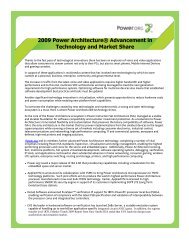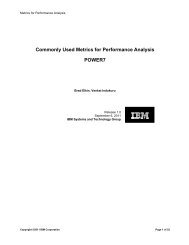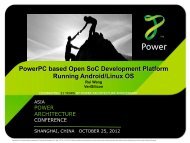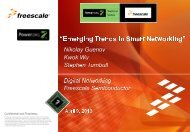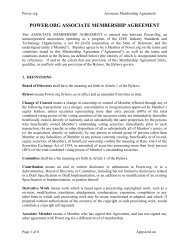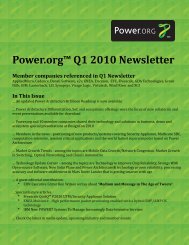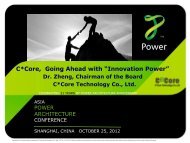Power Architecture Combines Rich Features for ... - Power.org
Power Architecture Combines Rich Features for ... - Power.org
Power Architecture Combines Rich Features for ... - Power.org
You also want an ePaper? Increase the reach of your titles
YUMPU automatically turns print PDFs into web optimized ePapers that Google loves.
Technology in<br />
context<br />
<strong>Power</strong> <strong>Architecture</strong> Stakes Its Claim<br />
<strong>Power</strong> <strong>Architecture</strong> <strong>Combines</strong> <strong>Rich</strong><br />
<strong>Features</strong> <strong>for</strong> Embedded<br />
Spanning applications from tiny, dedicated controllers to vast<br />
supercomputers, the <strong>Power</strong> <strong>Architecture</strong> offers advantages to the<br />
embedded space that include parallelism, multicore virtualization, power<br />
management and a rich selection of software tools.<br />
<strong>Power</strong> <strong>Architecture</strong>—<strong>Power</strong> ISA<br />
Key Differentiation<br />
Scalability, reliability, flexibility and<br />
the open collaborative model of <strong>Power</strong>.<strong>org</strong><br />
are some of the characteristics that differentiate<br />
the <strong>Power</strong> ISA from all others and<br />
influence the evolution of <strong>Power</strong> <strong>Architecture</strong><br />
into a unique position.<br />
“Set-tops to Teraflops” is the tagline<br />
that <strong>Power</strong>.<strong>org</strong> uses to communicate the<br />
inherent scalability of the <strong>Power</strong> <strong>Architecture</strong><br />
to the industry. <strong>Power</strong> <strong>Architecture</strong><br />
covers the most diverse set of markets<br />
including consumer electronics, industrial<br />
control, telecommunications and networking,<br />
high-per<strong>for</strong>mance computing, IT and<br />
commercial systems, aerospace and deby<br />
Fawzi Behmann, <strong>Power</strong>.<strong>org</strong><br />
<strong>Power</strong> <strong>Architecture</strong> processing technology<br />
is the common thread <strong>for</strong> a <strong>Power</strong>QUICC, QorIQ P & T series <strong>for</strong><br />
consoles, Px series <strong>for</strong> microcontrollers,<br />
very broad range of devices, based networking and communications. The<br />
loration on 32/64-bit <strong>Architecture</strong>. It is a ubiquitous<br />
architecture with more than a bil-<br />
and Storage, Axxia series <strong>for</strong> carrier<br />
list continues with Packet Pro <strong>for</strong> WLAN<br />
our goal<br />
directly<br />
ge, the lion <strong>Power</strong> <strong>Architecture</strong>-based chips that grade and core networks, 7xx & 9xx <strong>for</strong><br />
ource. have been built into electronics equipment mission-critical applications and High<br />
logy, since 1991.<br />
Per<strong>for</strong>mance Computing (HPC), POWproducts<br />
<strong>Power</strong> <strong>Architecture</strong> technology is the ERx <strong>for</strong> servers & workload optimization,<br />
basis <strong>for</strong> an extraordinary range of products,<br />
from supercomputers with 213,000<br />
processors to tiny automotive controllers<br />
dissipating less than a watt of power.<br />
<strong>Power</strong> <strong>Architecture</strong> technology is used in<br />
everyday household electronics—printers,<br />
ies providing HDTVs, solutions video nowrecorders, game consoles—<br />
Blue Gene supercomputers and Watson,<br />
licensable cores, full featured Virtex FP-<br />
GAs from Xilinx and hybrid processing<br />
devices (Figure 1).<br />
Every <strong>Power</strong> <strong>Architecture</strong> technology-based<br />
chip is rooted in the <strong>Power</strong> Instruction<br />
Set <strong>Architecture</strong> (ISA) and processing<br />
the latest specifications spanning server and<br />
on into products, as well technologies as more and exotic companies. electronics, Whether your such goal as is to research<br />
tion Engineer, or jump to a company's technical page, the goal of Get Connected is to put you<br />
satellites and the Mars Rover Lander. This<br />
you require <strong>for</strong> whatever type of technology,<br />
and products makes you are searching it well <strong>for</strong>. suited <strong>for</strong> any advanced<br />
electronic application offering the best<br />
per<strong>for</strong>mance per watt.<br />
<strong>Rich</strong> Set of Chip Families,<br />
Diversity, Applications and<br />
Market Share<br />
<strong>Power</strong> <strong>Architecture</strong> technology underlines<br />
many well-known chip families<br />
End of Article<br />
<strong>for</strong> 32-bit and 64-bit architecture, including<br />
the Cell Broadband Engine <strong>for</strong> game<br />
Get Connected<br />
with companies mentioned in this article.<br />
www.rtcmagazine.com/getconnected<br />
embedded computing capabilities. <strong>Power</strong><br />
ISA is the only architecture in the market<br />
that has proven implementations from the<br />
smallest devices to the largest supercomputers<br />
while covering a diverse set of markets.<br />
<strong>Power</strong> ISA features are familiar to<br />
thousands of software, hardware and tool<br />
developers who have worked with <strong>Power</strong>PC<br />
devices <strong>for</strong> many years. The most<br />
recent <strong>Power</strong> ISA 2.06 extends the edge<br />
<strong>Power</strong> ISA has in HPC and computationintensive<br />
workloads; provides enhancements<br />
to the server space such as memory<br />
management, processor version compatibility<br />
features and cache management;<br />
and also introduces a number of capabilities<br />
<strong>for</strong> the embedded space such as embedded<br />
hypervisor, energy management,<br />
multicore and multithreading.<br />
According to IMS Research, <strong>Power</strong><br />
<strong>Architecture</strong> is $4.4 billion of the total<br />
32/64-bit microprocessor market spanning<br />
the eight major markets and expanding<br />
into 30 vertical market segments.<br />
Among ARM, MIPS, SPARC, X86 and<br />
others, <strong>Power</strong> <strong>Architecture</strong> microprocessor<br />
revenue was ranked as the number<br />
one worldwide market share leader in 32-<br />
bit MPU, and the number two worldwide<br />
market share leader in 64-bit CPU (Figure<br />
2).<br />
18 REPRINTED MAY FROM 2012 MAY RTC 2012 MAGAZINE RTC MAGAZINE<br />
Get Connected with companies mentioned in this article.
technology in context<br />
<strong>Power</strong> <strong>Architecture</strong> Silicon Roadmap<br />
The Heart of Ecosystem<br />
Applied<br />
Micro<br />
Freescale IBM LSI C*Core China<br />
Chip<br />
GDA<br />
Tech.<br />
IPextreme Synopsys VeriSilicon Xilinx<br />
32-bit Commercial Processors<br />
32-bit Commercial Cores<br />
Historical Current Future Historical Current Future<br />
460SX 450EX/GT<br />
440 440S 440E 440G<br />
405E 405EX<br />
APM 86XXX<br />
APM 821XX APM 801XX<br />
QorlQ P40xx<br />
QorlQ P30xx<br />
QorlQ P20xx<br />
QorlQ P10xx<br />
75x 7410 74XX 8641D<br />
<strong>Power</strong>QUICC III – 85xx<br />
<strong>Power</strong>QUICC II Pro– 83xx 8308/09<br />
<strong>Power</strong>QUICC II – 82xx<br />
<strong>Power</strong>QUICC I – 8xx<br />
P51xx/52xx<br />
P5XX/ 55xx/ 56xx<br />
750GX<br />
750FX<br />
750CXe / CXr<br />
750L<br />
750GL<br />
750CL<br />
Dual 440 Blue Gene/L/ P<br />
Packet Pro+<br />
SLIM Pro<br />
Axxia Comm. Proc.<br />
Next-gen<br />
465<br />
c500mc<br />
e200/e300/e500/e600<br />
476<br />
440<br />
405/440 464<br />
476<br />
480<br />
460<br />
40582 / 440T90<br />
c200<br />
405S / 440S 405S2 / 460S<br />
450<br />
64-bit Commercial Processors<br />
Historical Current Future<br />
970FX<br />
970MP / GX<br />
POWER1/2/3/4/5 POWER6 POWER7 P7 755QDR <strong>Power</strong>8<br />
64-bit Commercial Cores<br />
QorlQ P55xx/T4xxxAMP<br />
Historical Current Future<br />
Next-gen (A2)<br />
Next-gen<br />
e5500/e65xx<br />
Hybrid or Accelerator <strong>Architecture</strong>s<br />
Historical Current Future<br />
Cell/<strong>Power</strong>Xcell/Blue Gene/L/P Blue Gene/Q/Blue Waters<br />
Watson<br />
Virtex-II Pro Virtex-4 FX Virtex-5 FXT<br />
Figure 1<br />
<strong>Power</strong> R&D roadmap delivering scale, scope and range.<br />
fense, high-end printers and imaging solutions.<br />
This is a testament to <strong>Power</strong> <strong>Architecture</strong>’s<br />
scalability in that it can address<br />
a vast array of applications while preserving<br />
the binary compatibility of software.<br />
The reliability of <strong>Power</strong> <strong>Architecture</strong><br />
implementations is evidenced by the many<br />
mission-critical applications in aerospace<br />
and defense, such as all the Mars Rover<br />
landings that used <strong>Power</strong> <strong>Architecture</strong><br />
chips. <strong>Power</strong> <strong>Architecture</strong> maintains the<br />
leading share of safety-critical automotive<br />
embedded systems and has a proven<br />
track record of reliability in servers with<br />
the lowest soft error rates under a barrage<br />
of proton and neutron radiation.<br />
<strong>Power</strong> ISA covers both 32-bit and<br />
64-bit variants and provides facilities <strong>for</strong><br />
expressing instruction level parallelism<br />
(ILP), data level parallelism, and thread<br />
level parallelism that give the programmer<br />
the flexibility to extract the particular<br />
combination of parallelism that is optimal.<br />
The ability of <strong>Power</strong> <strong>Architecture</strong> to<br />
provide instruction, data and thread level<br />
parallelism has enabled a variety of parallel<br />
systems, including some notable supercomputers.<br />
<strong>Power</strong> ISA allows exposing<br />
and extraction of ILP primarily because<br />
of the RISC principles embodied in the<br />
REPRINTED RTC FROM MAGAZINE RTC MAGAZINE MAY 2012 MAY 2012 19
technology in context<br />
Figure 2<br />
<strong>Power</strong> <strong>Architecture</strong> is $4.8 billion of total 32/64-bit microprocessor market<br />
spanning eight major (embedded and compute) markets.<br />
<strong>for</strong> the POWER7 processor and e500 multicore<br />
regarding hypervisor and virtualization<br />
on single and multicore implementations<br />
<strong>for</strong> the embedded market. Thus,<br />
<strong>Power</strong> ISA 2.06 enabled virtualization <strong>for</strong><br />
embedded hypervisor and other virtualization<br />
technologies.<br />
In the embedded space, the hypervisor<br />
is a true hardware-supported operating<br />
mode that ensures protection of the<br />
virtual kernel from guest operating systems.<br />
Thus, the hypervisor allows different<br />
software systems to run on different<br />
cores at the same time with high integrity.<br />
This approach allows each software system<br />
and its associated private hardware<br />
resources to be protected. While different<br />
systems are insulated from direct interactions,<br />
software systems can establish<br />
communication mechanisms with other<br />
software systems in a controlled and reliable<br />
manner. This results in simplifying<br />
software development by creating an abstraction<br />
layer of capabilities <strong>for</strong> the underlying<br />
cores.<br />
ISA. The reduced set of fixed length instructions<br />
enables simple hardware implementation<br />
that can be efficiently pipelined,<br />
thus increasing concurrency. The larger<br />
register set provides several optimization<br />
opportunities <strong>for</strong> the compiler as well as<br />
the hardware.<br />
Processors implementing the <strong>Power</strong><br />
ISA have been used to create several notable<br />
parallel computing systems, including<br />
the IBM RS/6000 SP, the Blue Gene<br />
family of computers, the Deep Blue chess<br />
playing machine, the PERCS system, the<br />
Sony PlayStation 3 game console and the<br />
Watson system that competed in the popular<br />
television show Jeopardy!<br />
Multicore SoC and Virtualization<br />
<strong>Power</strong> <strong>Architecture</strong> technology was<br />
an early participant in the world of multicore<br />
SoC. IBM Systems and Technology<br />
Group and <strong>Power</strong> <strong>Architecture</strong> embedded<br />
partners and customers have been implementing<br />
multicore designs since 2001. The<br />
ubiquitous <strong>Power</strong>QUICC processors from<br />
Freescale, which were launched in the<br />
mid ’90s, have always been heterogeneous<br />
multicore devices. In 1995, Freescale introduced<br />
MPC860, which had two cores—<br />
one based on <strong>Power</strong> <strong>Architecture</strong> technology<br />
and the other was proprietary RISC<br />
architecture. In 2001, IBM’s POWER4<br />
incorporated dual cores on a single die.<br />
It also was the first to implement a multichip<br />
module containing four POWER4<br />
microprocessors in a single package. More<br />
recently, Freescale’s QorIQ families (P1,<br />
P2, P3, P4 and P5) implement from 1 to<br />
8 <strong>Power</strong> <strong>Architecture</strong> cores, emphasizing<br />
hypervisor and virtualization. Additionally,<br />
the POWER7-based supercomputer,<br />
Blue Waters, was announced to support<br />
200,000 processors, bringing multi-petaflops<br />
per<strong>for</strong>mance in 2010-2011.<br />
The challenge of how to efficiently<br />
program and automate software development<br />
<strong>for</strong> multicore devices has been addressed<br />
by <strong>Power</strong>.<strong>org</strong> via multiple ISA<br />
and technical initiatives. <strong>Power</strong> ISA 2.04<br />
was finalized in June 2007 and includes<br />
changes regarding virtualization, hypervisor<br />
functionality, logical partitioning<br />
and virtual page handling. Additional enhancements<br />
resulted in ISA 2.05 released<br />
in December 2007, which supports decimal<br />
arithmetic and server hypervisor improvements.<br />
<strong>Power</strong> ISA 2.06 was released<br />
in February 2009 and included extensions<br />
Energy Management<br />
<strong>Power</strong> <strong>Architecture</strong> cores provide<br />
important capabilities <strong>for</strong> dynamic power<br />
management. Some of these are enabled<br />
internally in the core. For example, it is<br />
common <strong>for</strong> execution units in the processor<br />
pipeline to be power-gated when idle.<br />
Furthermore, <strong>Power</strong> <strong>Architecture</strong> cores<br />
offer software-selectable power-saving<br />
modes. These power-saving modes reduce<br />
function in other areas, with some<br />
modes limiting cache and bus-snooping<br />
operations, and some modes turning off<br />
all functional units except <strong>for</strong> interrupts.<br />
These techniques are an effective way to<br />
reduce power, because they reduce switching<br />
on the chip and give operating systems<br />
a means to exercise dynamic power management.<br />
But sometimes only the application<br />
software running on the processor has the<br />
knowledge required to decide when power<br />
can be managed without affecting per<strong>for</strong>mance.<br />
Recognizing this fact, <strong>Power</strong> <strong>Architecture</strong><br />
Embedded Supervisor <strong>Architecture</strong><br />
provides application software with<br />
a means <strong>for</strong> power-optimized solutions<br />
through the wait instruction (<strong>Power</strong> ISA<br />
2.06). This instruction allows software to<br />
20 REPRINTED MAY FROM 2012 MAY RTC 2012 MAGAZINE RTC MAGAZINE
technology in context<br />
initiate power savings when it is known<br />
that there is no work to do until the next<br />
interrupt. With this instruction, power<br />
savings can now be achieved through usermode<br />
code. This feature, <strong>for</strong> example, is<br />
well matched to the requirements of the<br />
LTE market segment, which requires that<br />
total SoC power be managed effectively.<br />
The combination of CPU power-savings<br />
modes, the wait instruction and the ability<br />
to wake on an interrupt has been demonstrated<br />
to achieve deep sleep power savings<br />
with wake up on external event—with<br />
no packet loss.<br />
Software Development<br />
Environment<br />
<strong>Power</strong> <strong>Architecture</strong> technology has<br />
the largest breadth and depth of development<br />
tools support in the industry. As expected,<br />
tools naturally congregate around<br />
the market segments where <strong>Power</strong> <strong>Architecture</strong><br />
technology is popular: servers,<br />
storage, networking, communications, automotive<br />
and digital media. <strong>Power</strong> <strong>Architecture</strong><br />
technology is supported by virtually<br />
all major operating system plat<strong>for</strong>ms<br />
and most minor ones as well.<br />
Full system simulation provides virtualization<br />
capabilities <strong>for</strong> the <strong>Power</strong><br />
<strong>Architecture</strong> community and helps software<br />
developers debug at the system level<br />
instead of at the individual board level.<br />
Developers are able to run simulations of<br />
their full systems, sometimes containing<br />
hundreds of different boards with many<br />
different kinds of processors, SoCs, devices<br />
and communication buses. This<br />
simulation helps identify per<strong>for</strong>mance<br />
enhancements and improves time-to-market<br />
through early identification of system<br />
trouble spots.<br />
<strong>Power</strong>.<strong>org</strong> and its members further<br />
advanced <strong>Power</strong> <strong>Architecture</strong> technology,<br />
completing a number of vital initiatives<br />
including <strong>Power</strong> ISA standards, hypervisor,<br />
virtualization and energy management,<br />
enabling the highest per<strong>for</strong>ming<br />
processors and cores <strong>for</strong> the server and<br />
embedded space.<br />
Advancements in the <strong>Power</strong> <strong>Architecture</strong><br />
technology continue to provide<br />
designers and developers with scalability,<br />
reliability and flexibility needed in their<br />
diverse markets. Moving <strong>for</strong>ward, <strong>Power</strong><br />
<strong>Architecture</strong> technology’s focus on energy<br />
management, multicore/virtualization,<br />
SoC plat<strong>for</strong>ms and software development<br />
environments will enable <strong>Power</strong><br />
<strong>Architecture</strong> technology to continue to be<br />
a ubiquitous architecture in the industry,<br />
helping to drive many new and exciting<br />
applications.<br />
<strong>Power</strong>.<strong>org</strong><br />
[www.power.<strong>org</strong>].<br />
REPRINTED RTC FROM MAGAZINE RTC MAGAZINE MAY 2012 MAY 2012 21




